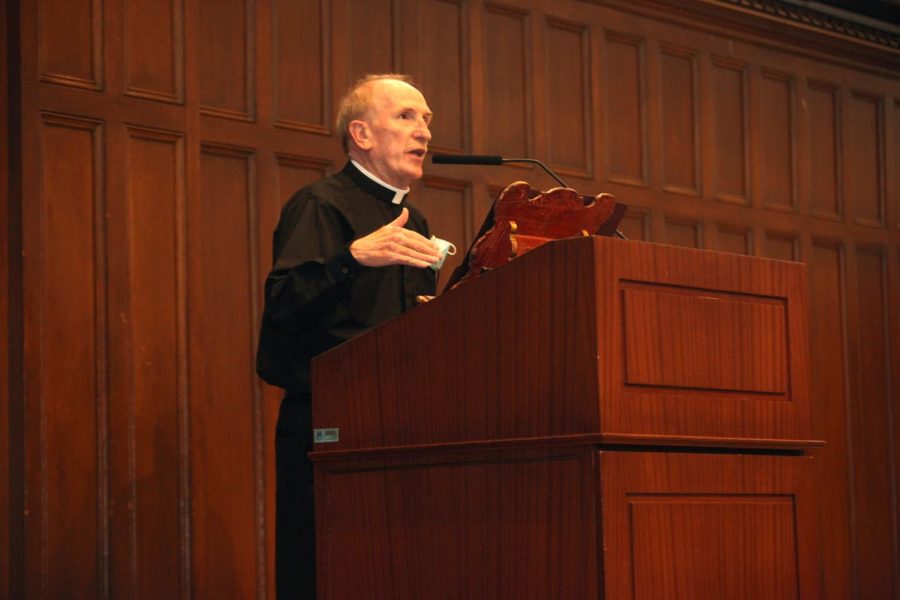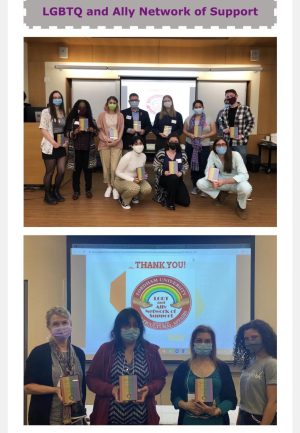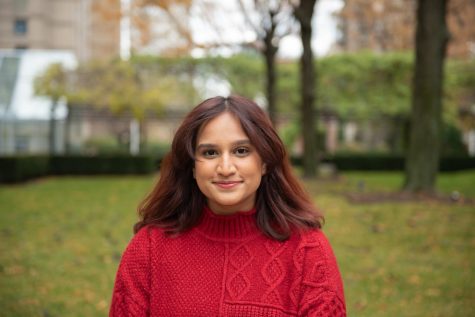McShane Delivers His Final State of University Address
In his speech, McShane discussed increased representation in admissions and plans to confront racism
COURTESY OF TOM STOELKER/FORDHAM NEWS
McShane gives the State of the University address on Oct. 18. He emphasized diversity and fundraising.
November 8, 2021
CORRECTION: A previous version of this article stated that Omi Mehta was a student in Fordham College at Lincoln Center. Mehta is in the Gabelli School of Business at Lincoln Center.
President of Fordham University Rev. Joseph M. McShane, S.J., delivered his State of the University address on Oct. 18. His speech discussed the increase in fundraising for the 2020-21 academic year, his goals for increased diversity and his plan to tackle racism on campus.
During the 2019-20 academic year, Fordham raised $53,338,612 — a couple million dollars less than the previous year. This year, Fordham raised $83,727,733, a record-breaking amount, making 2021 “the university’s best fundraising year ever.”
A new fundraising campaign — Cura Personalis: For Every Fordham Student — has been launched as a part of the school’s comprehensive campaign, which aims to increase access, affordability, academic excellence, student wellness and athletics.
Fordham received 46,160 applications for admission for the 2021-22 academic year, and admission was offered to 58.3% of applicants, yielding a total enrollment of 2,848 students — an increase of almost 800 from last year. This change led to the largest first-year class in Fordham’s history.
“COVID-19 is not the only pandemic we are wrestling with. We are also wrestling with racism, a pandemic that sadly will take longer to address and overcome.” University President Rev. Joseph M. McShane, S.J.
McShane has claimed to “once again hold fusion events” which allow both alumni and prospective students to meet. McShane said he expects these events to help “immensely with admission rates this upcoming year.”
The large first-year class also led to increased representation in terms of race. This year, 44% of enrolled students are from “traditionally underrepresented groups in American society,” a 5% increase from last year. The number of African American students enrolled increased from 76 to 189, a 149% increase. Hispanic student representation grew from 328 to 515 students, a 57% increase.
“COVID-19 is not the only pandemic we are wrestling with. We are also wrestling with racism, a pandemic that sadly will take longer to address and overcome,” McShane said.
McShane reported that Fordham has adopted an action plan for confronting racism and educating for justice and a strategic plan (educating for justice) that supplements the aspirations within the action plan.
“As a result of our roots, our mission calls us to treat not just every member of the Fordham community but indeed every human being with respect, affirmation, reverence and affection,” McShane said. “That same mission calls upon us to confront racism and to educate for justice.”
Students at Fordham Lincoln Center had differing views on how Fordham is handling increasing diversity. Lorena Loza, Fordham College at Lincoln Center (FCLC) ’25, said that she approved of McShane’s plans.
“That is awesome especially because the African American and Hispanic communities are typically underrepresented and underserved. Coming here to Fordham and getting these opportunities is incredible,” Loza said. “In New York, there is diversity everywhere and Fordham should definitely continue to build its diversity because we need everyone to build a community.”
“Fordham is believed to become more inclusive, with an increasing number of minority groups coming every year, but it is ironic … that I see very few colored people.” Omi Mehta, GSBLC ’25
However, not all Fordham members are impressed.
“Fordham is believed to become more inclusive, with an increasing number of minority groups coming every year, but it is ironic to see that in my core classes which are meant to have a lot of students, I see very few people of color,” Omi Mehta, Gabelli School of Business at Lincoln Center ’25, said.
“Moreover, as an Indian person, it is even more frustrating to see that Fordham Lincoln center offers only one club, Desi Chai, for South Asians,” Mehta continued. “With such limited options, it is hard for minority groups to feel included, and I myself have felt that Fordham can do better with diversity.”
Mehta said as a first-year student, she is looking forward to seeing what the university does to make the school more inclusive for everyone. She said she hopes the improvements come soon.
“(Fordham) remains no. 41 among all private research universities in the country.” Joseph McShane
McShane also commented on Fordham’s rankings this year. In U.S. News & World Report. Fordham’s ranking fell two places from 66 to 68.
“(Fordham) remains no. 41 among all private research universities in the country, no. 7 among research universities in New York state, no. 6 among Catholic research universities, and no. 4 among Jesuit research universities,” McShane said.
U.S. News & World Report also ranked Fordham as no. 74 in “Best Value,” no. 18 in social mobility, and no. 17 in marketing. Some of the declining ratings included undergraduate business in which Fordham ranked no. 74 and international business in which Fordham ranked no. 11.
“Fordham is a really great school.” Lorena Loza, FCLC ’25
McShane addressed Fordham faculty’s scholarly work, which comprises 195 published books and book chapters and 525 articles. Departments with the most works published included arts and sciences, law, and education.
Fordham’s faculty also won $17.465 million in grants.
“Fordham is a really great school,” Loza said. “Fordham is going to keep getting better rankings especially with the way they’re increasing diversity and trying to get better fundraising.”














